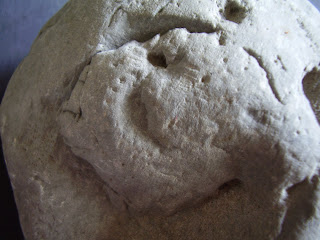Worked flint with possible human infant, buffalo, lion and mammoth iconography. The images are seen in this order by rotating the stone counter-clockwise.
Rick Doninger collection, south west Indiana, USA
Frame around image of infant or fetus-in-womb face.
The possible face of a human fetus or an infant is depicted within this "cycle-of-life" art piece. The earlier post "Peter Cottontail has left the building" also has a similar face of what looks like a baby or fetus depicted on what is a suspected rabbit "prey-mother" fertility piece. Both of the faces are in the lower left corner of the zoomorphic image and in a "V" position as if depicting a pre-birth orientation.
Rick Doninger is an amateur archaeologist located in south west Indiana. Rick has identified a stone working industry that is not explained by mainstream archaeology. It has strong similarities to European Mousterian and Levallois technology traditions. Rick's conclusion, based on thousands of artifacts, is that he has identified a unique paleolithic presence in the American midwest. Rick is an active commentator on about.com's archaeology forum regarding the possibility of the older presence of humans in North America than currently accepted by mainstream archaeologists. After years of work and research, Rick is gaining the attention of scholars who are interested in the potential age of the artifacts, and apparent full-blown industry, he has identified.
Possible bison image in right profile, head in upper right of artifact.
Artifact is rotated 90 degrees here.
With I.Y. Yotova et. al. (2011) x-haplotype genetic data indicating extensive mating of Neanderthals and anatomically modern humans across Eurasia with evidence found into First American populations, as well as the Denver Museum of Nature and Science returning site dates at 30,000 BP in Nebraska (center of North America), the great possibility exists of connections to Europe and Neanderthal culture, tools and art.
Rick Doninger's photo rotated a total of 180 degrees.
A feline icon is perched at the top left of the artifact. The lion is resting its head on its left paw, seen in left profile looking to photo left.
(click photo to expand)
Ken Johnston's markup on Rick Doninger's photo. The white line indicates the "ground" the feline (presumably lion) is lying on. There may be proboscidean imagery here, where the lion is being depicted as lying across the mammoth's head. The black circle is a possible mammoth eye, the black line crossing Rick's hand is the curvature of the possible mammoth's trunk line in right profile view.
A lion in this same position (left profile, head resting on left paw) lying across a white bison head was identified by Ken Johnston on this artifact found by Pam Douglass in Licking County, Ohio.
In both the Ohio and Indiana examples, the lion's belly is just touching the "eye" of the prey animal.
Here is a direct link to the white bison head posting:










































